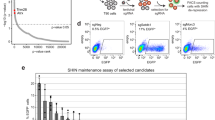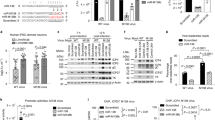Abstract
E4orf6 is one of the oncogene products of adenovirus, and it also has an important role for transportation of cellular and viral messenger RNA (mRNA) during the late phase of virus infection. We previously revealed that E4orf6 controls the fate of AU-rich element (ARE) containing mRNA by perturbing the chromosome maintenance region 1-dependent export mechanism. Here, we show that E4orf6 stabilizes ARE–mRNA through the region required for its oncogenic activity and ubiquitin E3 ligase assembly. Cells that failed to stabilize ARE–mRNA after HuR knockdown were unable to produce colonies in soft agar, even when E4orf6 was expressed. Furthermore, the stabilized ARE–mRNA induced the transformation of rodent immortalized cells. These findings indicate that stabilized ARE–mRNA is necessary, if not all, for the oncogenic activity of E4orf6 and has the potential to transform cells, at least under a certain condition.
This is a preview of subscription content, access via your institution
Access options
Subscribe to this journal
Receive 50 print issues and online access
$259.00 per year
only $5.18 per issue
Buy this article
- Purchase on Springer Link
- Instant access to full article PDF
Prices may be subject to local taxes which are calculated during checkout




Similar content being viewed by others
References
Aoyagi M, Higashino F, Yasuda M, Takahashi A, Sawada Y, Totsuka Y et al. (2003). Nuclear export of the adenovirus E4orf6 protein is necessary for its ability to antagonize the apoptotic activity of the BH3-only proteins. Oncogene 22: 6919–6927.
Baker A, Rohleder KJ, Hanakahi LA, Ketner G . (2007). Adenovirus E4 34k and E1b 55k oncoproteins target host DNA ligase IV for proteasomal degradation. J Virol 81: 7034–7040.
Blanchette P, Cheng CY, Yan Q, Ketner G, Ornelles DA, Dobner T et al. (2004). Both BC-box motifs of adenovirus protein E4orf6 are required to efficiently assemble an E3 ligase complex that degrades p53. Mol Cell Biol 24: 9619–9629.
Blanchette P, Kindsmüller K, Groitl P, Dallaire F, Speiseder T, Branton PE et al. (2008). Control of mRNA export by adenovirus E4orf6 and E1B55K proteins during productive infection requires E4orf6 ubiquitin ligase activity. J Virol 82: 2642–2651.
Brennan CM, Steitz JA . (2001). HuR and mRNA stability. Cell Mol Life Sci 58: 266–277.
Brennan CM, Gallouzi IE, Steitz JA . (2000). Protein ligands to HuR modulate its interaction with target mRNA in vivo. J Cell Biol 151: 1–14.
Brummelkamp TR, Bernards R, Agami R . (2002). Stable suppression of tumorigenicity by virus-mediated RNA interference. Cancer Cell 2: 243–247.
Chen CY, Shyu AB . (1995). AU-rich elements: characterization and importance in mRNA degradation. Trends Biochem Sci 20: 465–470.
Dallaire F, Blanchette P, Groitl P, Dobner T, Branton PE . (2009). Identification of integrin alpha3 as a new substrate of the adenovirus E4orf6/E1B55-kilodalton E3 ubiquitin ligase complex. J Virol 83: 5329–5338.
Dobbelstein M, Roth J, Kimberly WT, Levine AJ, Shenk T . (1997). Nuclear export of the E1B 55-kDa and E4 34-kDa adenoviral oncoproteins mediated by a rev-like signal sequence. EMBO J 16: 4267–4284.
Dobner T, Kzhyshkowska J . (2001). Nuclear export of adenovirus RNA. Curr Top Microbiol Immunol 259: 25–54.
Esclatine A, Taddeo B, Evans L, Roizman B . (2004). The herpes simplex virus 1 UL41 gene-dependent destabilization of cellular RNAs is selective and may be sequence-specific. Proc Natl Acad Sci USA 101: 3603–3608.
Fan XC, Steitz JA . (1998). HNS, a nuclear-cytoplasmic shuttling sequence in HuR. Proc Natl Acad Sci 95: 15293–15298.
Gallouzi IE, Brennan CM, Steitz JA . (2001a). Protein ligands mediate the CRM1-dependent export of HuR in response to heat shock. RNA 7: 1348–1361.
Gallouzi IE, Steitz JA . (2001b). Delineation of mRNA export pathways by the use of cell-permeable peptides. Science 294: 1895–1901.
Hasegawa H, Kakuguchi W, Kuroshima T, Kitamura T, Tanaka S, Kitagawa Y et al. (2009). HuR is exported to the cytoplasm in oral cancer cells in a different manner from that of normal cells. Br J Cancer 100: 1943–1948.
Higashino F, Aoyagi M, Takahashi A, Ishino M, Taoka M, Isobe T et al. (2005). Adenovirus E4orf6 targets pp32/LANP to control the fate of ARE-containing mRNA by perturbing the CRM1-dependent mechanism. J Cell Biol 170: 15–20.
Hinman MN, Lou H . (2008). Diverse molecular functions of Hu proteins. Cell Mol Life Sci 65: 3168–3181.
Kakuguchi W, Kitamura T, Kuroshima T, Ishikawa M, Kitagawa Y, Totsuka Y et al. (2010). HuR knockdown changes the oncogenic potential of oral cancer cells. Mol Cancer Res 8: 520–528.
Lopez de Silanes I, Lal A, Gorospe M . (2005). HuR: post-transcriptional paths to malignancy. RNA Biol 2: 11–13.
McCormick C, Ganem D . (2001). The kaposin B protein of KSHV activates the p38/MK2 pathway and stabilizes cytokine mRNA. Science 307: 739–741.
Moore M, Horikoshi N, Shenk T . (1996). Oncogenic potential of the adenovirus E4orf6 protein. Proc Natl Acad Sci USA 93: 11295–11301.
Nevels M, Rubenwolf S, Spruss T, Wolf H, Dobner T . (1997). The adenovirus E4orf6 protein can promote E1A/E1B-induced focus formation by interfering with p53 tumor suppressor function. Proc Natl Acad Sci USA 94: 1206–1211.
Nevels M, Rubenwolf S, Spruss T, Wolf H, Dobner T . (2000). Two distinct activities contribute to the oncogenic potential of the adenovirus type 5 E4orf6 protein. J Virol 74: 5168–5181.
Orlando JS, Ornelles DA . (1999). An arginine-faced amphipathic alpha helix is required for adenovirus type 5 E4orf6 protein function. J Virol 73: 4600–4610.
Orlando JS, Ornelles DA . (2002). E4orf6 variants with separate abilities to augment adenovirus replication and direct nuclear localization of the E1B 55-kilodalton protein. J Virol 76: 1475–1487.
Querido E, Blanchette P, Yan Q, Kamura T, Morrison M, Boivin D et al. (2001). Degradation of p53 by adenovirus E4orf6 and E1B55K proteins occurs via a novel mechanism involving a Cullin-containing complex. Genes & Dev 15: 3104–3117.
Rebane A, Aab A, Steitz JA . (2004). Transportins 1 and 2 are redundant nuclear import factors for hnRNP A1 and HuR. RNA 10: 590–599.
Sarnow P, Hearing P, Anderson CW, Halbert DN, Shenk T, Levine AJ . (1984). Adenovirus early region 1B 58 000-dalton tumor antigen is physically associated with an early region 4 25 000-dalton protein in productively infected cells. J Virol 49: 692–700.
Shenk T . (2001). Adenoviridae: the viruses and their replication. In: Knipe DM, Howley PM (eds). Fundamental Virology. Lippincott Williams & Wilkins: Philadelphia, pp 1053–1088.
Stracker TH, Carson CT, Weitzman MD . (2002). Adenovirus oncoproteins inactivate the Mre11-Rad50-NBS1 DNA repair complex. Nature 418: 348–352.
Woo JL, Berk AJ . (2007). Adenovirus ubiquitin-protein ligase stimulates viral late mRNA nuclear export. J Virol 81: 575–587.
Acknowledgements
We thank T Dobner for donating the E4orf6 mutant and mutant adenovirus expression plasmids, H Ariga for donating the c-myc expression vector, K Yoshida for donating the c-fos expression vector and L Agami for donating the pSUPER plasmid. This work was supported, in part, by a Grant-in-Aid for Scientific Research from the Ministry of Education, Science and Culture of Japan, and by a Grant-in Aid from the Akiyama Foundation.
Author information
Authors and Affiliations
Corresponding author
Ethics declarations
Competing interests
The authors declare no conflict of interest.
Additional information
Supplementary Information accompanies the paper on the Oncogene website
Supplementary information
Rights and permissions
About this article
Cite this article
Kuroshima, T., Aoyagi, M., Yasuda, M. et al. Viral-mediated stabilization of AU-rich element containing mRNA contributes to cell transformation. Oncogene 30, 2912–2920 (2011). https://doi.org/10.1038/onc.2011.14
Received:
Revised:
Accepted:
Published:
Issue Date:
DOI: https://doi.org/10.1038/onc.2011.14



